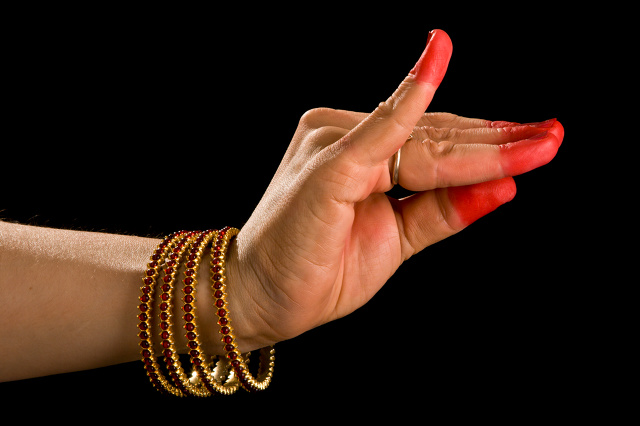Distinct single-handed hasta from the Bharatarnava

#WednesdayWisdom is a series that began during the 40th anniversary celebration of Akademi to revisit Indian classical dance roots by sharing gems of knowledge from ancient Shastras (dance texts) that hold relevance even today. The blog is curated by Bharatanatyam artist, Suhani Dhanki, along with with our Head of Marketing, Antareepa Thakur.
In this blog series, we are inviting artists practicing different South Asian dance styles to contribute some interesting facts about their art forms, some of them rarely seen in the UK. Read our previous blogs in this series here.
This blogpost on distinct hasta from Bharatarnava is compiled and written by Suhani, in consultation with her guru and renowned Bharatanatyam artist, Dr Sandhya Purecha.
The Bharatārṇava is a Sanskrit text ascribed to Nandikeśvara (different from the author of the Abhinayadarpanam). It is a standard text for ‘Nartana’. The word ‘Nartana’ is derived from the Sanskrit root word ‘Nrt’ which means to dance and comprises the two-fold elements of dance – Nritya (pantomime) and Nritta (pure dance).
Since the present edition of the text has been gathered from a number of sources, there are various unique hand gestures and their uses mentioned which are available to us.
Chapter I comprises the 27 Asamyuta Hasta – Single handed gestures
They are: Pataka, Tripataka, Ardhapataka, Kartarimukha, Mayura, Ardhachandra, Arala, Sukatunda, Mushti, Shikhara, Kapittha, Khatakamukha, Suchi, Padmakosha, Bāna, Sarpashirsha, Mrigashirsha, Simhamukha, Kangula, Alapallava, Chatura, Bhramara, Hamsasya, Samsapaksha, Sandamsha, Mukula, Tamrachuda
Chapter IV comprises the use of hastas according to Brihaspati
In this section, three new hastas are mentioned: Sarpachatura, Chalasarpakara, Khandachatura
Chapter V includes the Sankara hasta or miscellaneous uses of hands
Here, we find Rekha hasta, Nakhahamsa and Ardhamrigashirsha
Chapter X comprises Nānārtha Hastas – Gestures expressing varied ideas
Here, we find Ardhamukula and Patakachatura Hasta
These are further explained below:
1. Bāna Hasta(the arrow-like hand) – The first finger, middle finger and the ring finger are pressed down at their tops by the thumb and the little finger is stretched out
Uses:To indicate numeral 6, an angling rod, a bathing seat, object on the head or enacting erotic scenes
2. Sarpachatura Hasta (hood-like Chatura) – In Sarpashirsha hasta, the thumb is placed at the foot of the ring-finger.
Uses:To indicate honey, camphor
3. Chalasarpa Kara (The moving serpent) – In the Sarpashirsha hasta, the thumb is made to move touching all the fingers from the first finger to the little finger.
Uses:;To indicate the separation of units of tala into Kalaas (parts), in examining consistency of a pharmaceutical preparation, to denote the saala tree, and in applying ornamental red paint to the feet.
4. Khandachatura Hasta – In the Chatura hasta, the first finger is left off and the little finger is added.
Uses: To denote dust, something that is sweet-like nectar, a machine, wailing, breaking
5. Rekha Hasta – The middle finger is bent and the other fingers are stretched out.
Uses: To denote the face of elephants and in deep thought about a course of conduct
6. Nakhahamsa – The thumb is in contact with all the joints of the first finger, and the other fingers are stretched out
Uses: To indicate precious stones like diamond, the nails or the gem in the nose ornaments
7. Ardhamrigashirsha – In the Mrigashirsha Hasta, the ring finger is also separated
Uses: In personating a young woman and when using pacifying words
8. Ardhamukula – When Mukula hasta with the little fingers stretched out, held in both hands, are joined together.
Uses: To denote oneself, or other similar ideas according to circumstances
9. Shankara Hasta / Pataka Chatura Hasta – Pataka with the thumb at the foot of the little finger.
Uses: To denote white colour, the face, worshipping deities with burning camphor or a hermitage of leaves and creepers